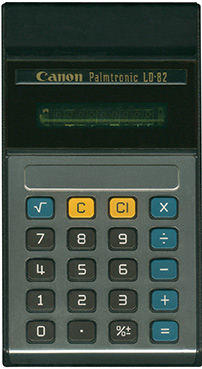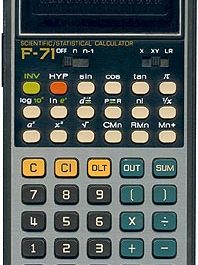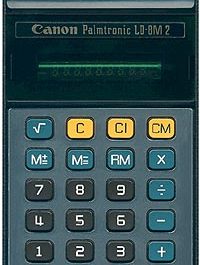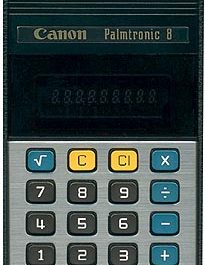
The Canon Palmtronic LD-82 calculator was first introduced in 1975 as one of Canon’s early handheld scientific calculators. Measuring just 71mm x 128mm x 22mm and weighing only 112g, the pocket-sized LD-82 featured a sleek, slimline design with a brushed aluminum keyboard surround and distinctive black plastic crocodile skin textured case. Powered by three AAA batteries, it packed an impressive 82 scientific functions into a compact package thanks to its 28-pin Texas Instruments TMS0855NC central processing unit.
The LD-82’s key specifications include an 8-digit vacuum fluorescent display, trigonometric and logarithmic capabilities, fractions, percentages, square roots, radians/degrees mode switching, and parentheses calculations. Negative numbers are denoted by a minus sign in the 9th digit of the display. Overflow errors are flagged by a “u” for positive overflows or “o” for negatives, with the decimal point indicating the number of overflowed digits. Despite its diminutive form factor, the LD-82 delivers up to 10 digits of precision for scientific work.

Inside, the main circuit board houses the TMS0855NC CPU along with an array of diodes, transistors, capacitors, and resistors. A separate smaller board contains the DC power adapter circuitry. The keyboard clicks into place and connects via 20 gold-plated pins. To access the internals, the back case needs to be gently pried open from the top and then swung out on rear hinges.
Overall, the LD-82 provided good value for students, engineers, and professionals needing an affordable shirt-pocket scientific calculator in the mid-1970s. Its combination of portability, battery power, display visibility, and mathematical capabilities made it popular for several years before being superseded by more advanced models. The LD-82 retailed for around $40 when it first launched, undercutting competitors like Hewlett Packard and Texas Instruments. Today it represents an important milestone in Canon’s early move into electronics and personal calculator products.


